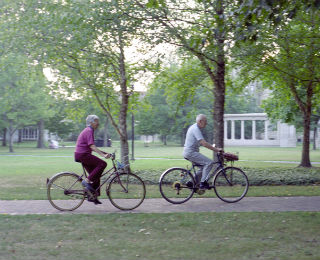Published: November 9, 2015
Written By: Molly Kavanaugh
 The music is loud and unfamiliar. The exercise class is scheduled too early, or too late.
The music is loud and unfamiliar. The exercise class is scheduled too early, or too late.
These are just a couple of reasons older adults might be reluctant to sign up for a class or why they drop out of one.
But you might want to reconsider. An exercise class can do more for you than just improve your physical health, according to Canadian fitness instructor Susan Ingraham.
“Exercise can raise endorphins which improve your mood. One participant walked into my fitness class one morning and handed me her ticket, saying, “Here I am. Do your magic.” At the end of class, she told me her mood had improved 100%. I know this can happen because I have experienced it many times myself,” Susan writes.
Social Connections Improve Moods
Joining a bike club or signing up for a spinning class gives you—along with its health benefits—an opportunity to meet new people and interact with men and women of multiple generations.
Why is this so important for older adults? According to the Federal Occupational Health:
-
Relationships and social support are a key part of healthy aging. In fact, staying connected and socially involved can help to protect you from feelings of isolation, loneliness, and depression.
-
Being socially engaged may also ward off poor health and ultimately help you maintain your overall well-being.
-
Various studies have shown that older adults who participate in activities they find meaningful often report feeling healthier and happier.
Along with joining an exercise group, the federal agency recommends dancing and participating in activities at your local community center.
Finding the Right Group Exercise Class
Interested in exploring the socialization benefits of group exercise but not sure which class to sign up for? Here are a few questions to help you select a class that’s right for you:
-
Do you have physical limitations that make it difficult to perform some exercises? Physical limitations should never keep you from exercising entirely, but they can impact the type of group exercises you can do. For example, if you suffer from arthritis, low-impact exercises like water tai chi will likely be more beneficial than a fast-paced, high-energy dance class.
-
Do you want to stick with something you know or trying something new? Joining a new group class can be intimidating, which is why many people prefer to stick with something they know. Other people feel trying something new is half the fun of exercise. Which are you?
-
Are you more comfortable exercising in a large or small group? Depending on the class and where you’re taking it, some group exercise classes can attract large groups of gym goers. Others just have a handful of regular attendees. Ask yourself if you would feel more comfortable exercising and socializing in large groups or small.
Still Not Convinced?
Staying socially active, whether it’s joining an exercise class, spending time with close friends or volunteering, is good for your overall health, according to the University of Rochester Medical Center.
Benefits include:
-
Potentially reduced risk for cardiovascular problems, some cancers, osteoporosis, and rheumatoid arthritis
-
Potentially reduced risk for Alzheimer's disease
-
Lower blood pressure
-
Reduced risk for mental health issues such as depression
Regular exercise and physical activity also increases flexibility, mobility and balance, controls weight, and improves sleep.
The bottom line to exercise, according to the Mayo Clinic, is that it’s “a great way to feel better, gain health benefits and have fun.”
Aim for 30 minutes of daily activity. Be sure to talk to your doctor before signing up for a class or starting a new activity, especially if you have been inactive or are recovering from an injury or illness.
And don’t be shy about suggesting different workout tunes to your fitness instructor. It just might also open the door to making friends with your classmate.
 Written By: Molly Kavanaugh
Written By: Molly Kavanaugh





